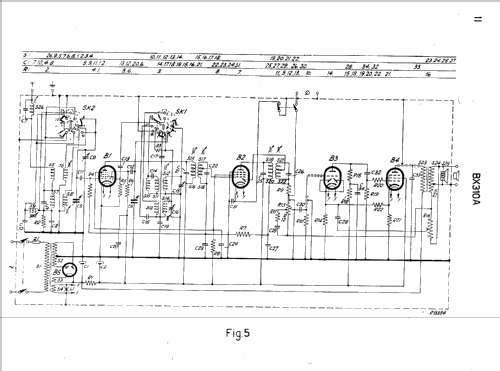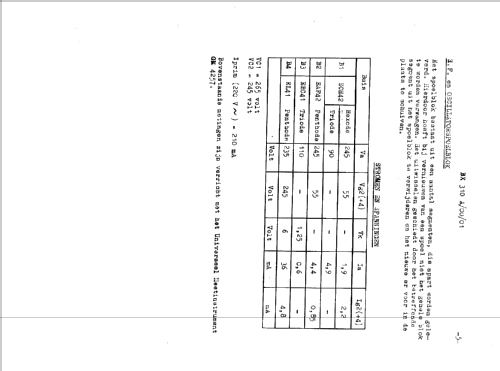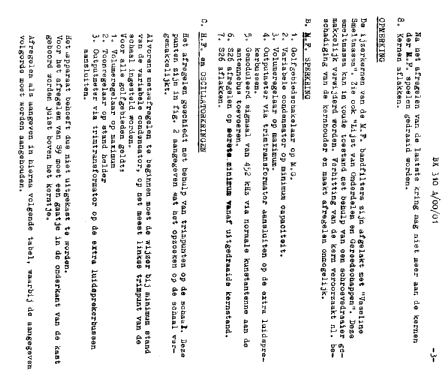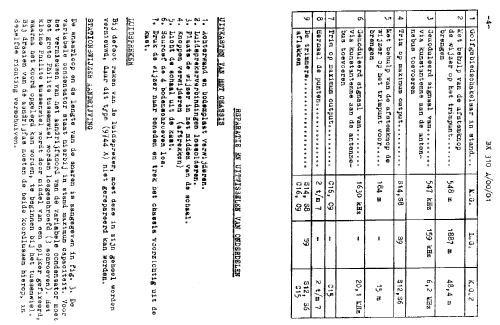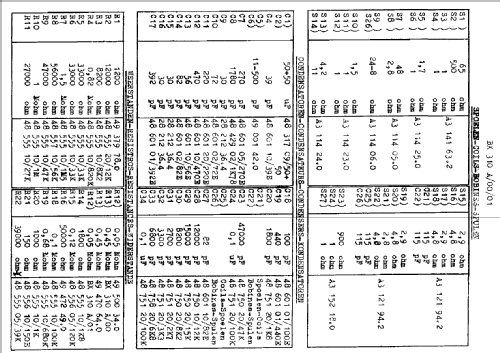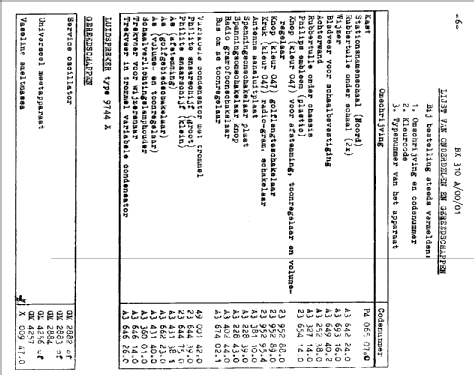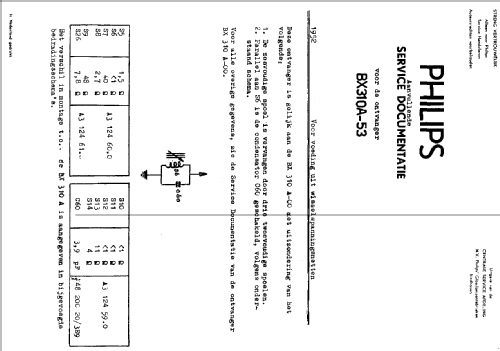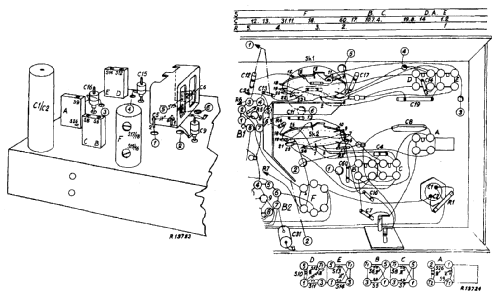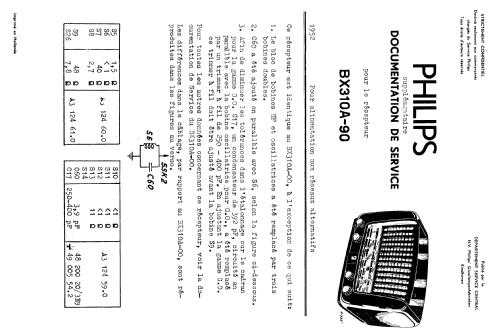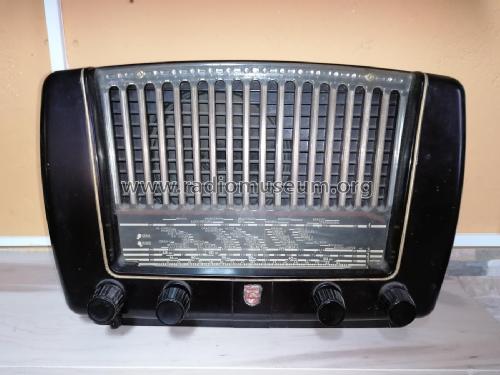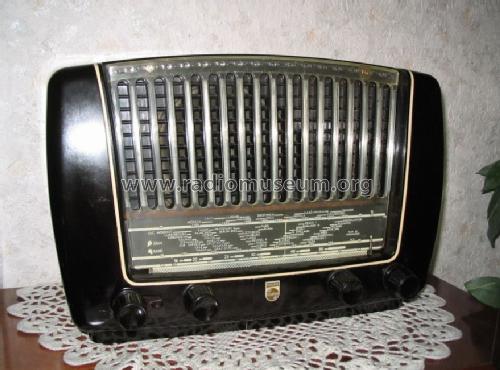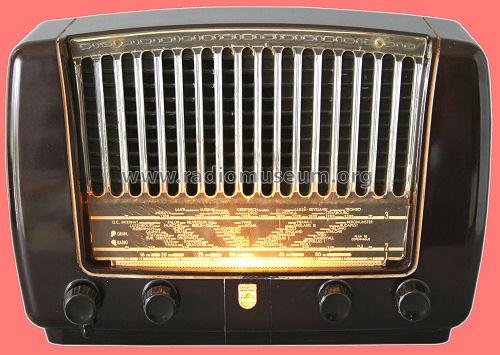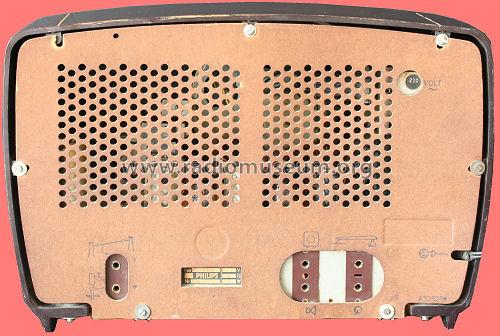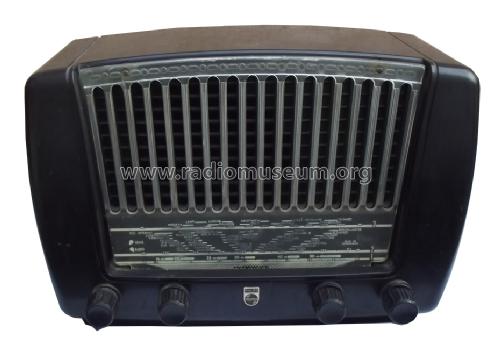BX310A (BX310A /00)
Philips; Eindhoven (tubes international!); Miniwatt
- Land
- Niederlande
- Hersteller / Marke
- Philips; Eindhoven (tubes international!); Miniwatt
- Jahr
- 1951–1953
- Kategorie
- Rundfunkempfänger (Radio - oder Tuner nach WW2)
- Radiomuseum.org ID
- 29832
Klicken Sie auf den Schaltplanausschnitt, um diesen kostenlos als Dokument anzufordern.
- Anzahl Röhren
- 5
- Hauptprinzip
- Superhet allgemein; ZF/IF 452 kHz; 2 NF-Stufe(n)
- Anzahl Kreise
- 6 Kreis(e) AM
- Wellenbereiche
- Langwelle, Mittelwelle und Kurzwelle.
- Betriebsart / Volt
- Wechselstromspeisung / 110; 125; 145; 200; 220; 245 Volt
- Lautsprecher
- Dynamischer LS, keine Erregerspule (permanentdynamisch) / Ø 15 cm = 5.9 inch
- Belastbarkeit / Leistung
- 3 W (Qualität unbekannt)
- Material
- Bakelit (Pressstoff)
- von Radiomuseum.org
- Modell: BX310A - Philips; Eindhoven tubes
- Form
- Tischgerät-gross, - Querformat (breiter als hoch oder quadratisch).
- Abmessungen (BHT)
- 380 x 250 x 200 mm / 15 x 9.8 x 7.9 inch
- Bemerkung
-
AM radio for external antenna:
- LW: 152 - 285 kHz.
- BC: 517 - 1622 kHz.
- SW: 5,92 - 18,2 MHz.
Loudspeaker: 9744X (5Ω).Dial lamp: 8045D (E10, 6,3V/320mA).In versions /53 and /90, there are some slight modifications in the parts but not in the general specifications. See the specific version schematics with this model page.
- Nettogewicht
- 5.9 kg / 12 lb 15.9 oz (12.996 lb)
- Datenherkunft
- Technisch- Commercieel - Radio Vademecum Staleman
- Literatur/Schema (1)
- -- Original-techn. papers.
- Literatur/Schema (2)
- Dépliant Nouvelle Série Philips Radio 1953, Sept. 1952
- Autor
- Modellseite von Iven Müller angelegt. Siehe bei "Änderungsvorschlag" für weitere Mitarbeit.
- Weitere Modelle
-
Hier finden Sie 5279 Modelle, davon 4427 mit Bildern und 3462 mit Schaltbildern.
Alle gelisteten Radios usw. von Philips; Eindhoven (tubes international!); Miniwatt
Sammlungen
Das Modell befindet sich in den Sammlungen folgender Mitglieder.
Forumsbeiträge zum Modell: Philips; Eindhoven: BX310A
Threads: 1 | Posts: 6
Hello Forum,
I am restoring a Philips radio type BX310A from 1951/-52. It is generally in quite good shape but has one painful fault; namely internal arcing (= random short circuit) between primary/secondary winding -S23- S24 in the audio output transformer. Trafo's Philips code is A3 152 18.0, and iron core (E+I) size is 40*37*16mm3. Output tube is EL 41 and O/P power 2-3W? The trafo is compact and impregnated with " black tar " so very difficult to open and rewind.
This fault had very interesting symptoms and not so easy to discover. When I smoothly increased AC input voltage by Variac, so around 150V became random "crackle" audible. At the same time one or more arcs happened on tube base socket from anode pin to ground (about 5mm) also a few arcs were visible inside of the tube, especially with higher AC input. These phenomena continued with random rate. Following the anode voltage with oscilloscope showed that the voltage dropped sharply during "crackles". I changed several components and also EL41 + socket at O/P stage without success.
So my final conclusion was a high resistant short circuit between the primary and secondary windings inside of the trafo. One leg of secondary is grounded. Attached drawing shows how I think this phenomenon happens. I also tested the trafo separately with DC voltage and the "crackle " repeated. Normal ohmmeter did not indicate leaking between windings.
Does the arcing happen due to "Spark Coil" effect just like in cars??
Can somebody to advice me are there any means to repair the trafo? Due to trafo construction, rewinding of it look very difficult because of the primary section seems to be top layer. What about availability of adequate replacement trafo (new or surplus)
Best regards
Ake Nyholm
I am restoring a Philips radio type BX310A from 1951/-52. It is generally in quite good shape but has one painful fault; namely internal arcing (= random short circuit) between primary/secondary winding -S23- S24 in the audio output transformer. Trafo's Philips code is A3 152 18.0, and iron core (E+I) size is 40*37*16mm3. Output tube is EL 41 and O/P power 2-3W? The trafo is compact and impregnated with " black tar " so very difficult to open and rewind.
This fault had very interesting symptoms and not so easy to discover. When I smoothly increased AC input voltage by Variac, so around 150V became random "crackle" audible. At the same time one or more arcs happened on tube base socket from anode pin to ground (about 5mm) also a few arcs were visible inside of the tube, especially with higher AC input. These phenomena continued with random rate. Following the anode voltage with oscilloscope showed that the voltage dropped sharply during "crackles". I changed several components and also EL41 + socket at O/P stage without success.
So my final conclusion was a high resistant short circuit between the primary and secondary windings inside of the trafo. One leg of secondary is grounded. Attached drawing shows how I think this phenomenon happens. I also tested the trafo separately with DC voltage and the "crackle " repeated. Normal ohmmeter did not indicate leaking between windings.
Does the arcing happen due to "Spark Coil" effect just like in cars??
Can somebody to advice me are there any means to repair the trafo? Due to trafo construction, rewinding of it look very difficult because of the primary section seems to be top layer. What about availability of adequate replacement trafo (new or surplus)
Best regards
Ake Nyholm
Anlagen
- Ph310_audiotrafo-small (149 KB)
- EL41 anodipiiri (18 KB)
Ake Nyholm, 08.Mar.05
